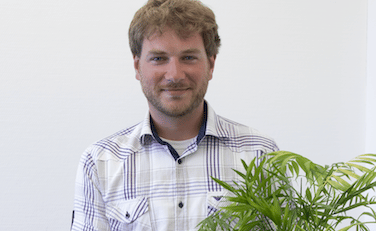

Jan-Hendrik Carstensen is studying business informatics at the University of Kiel in Northern Germany and analyses the NeoMesh technology for his bachelor thesis
| Share |
|
While studying business informatics at the University of Kiel in Northern Germany, Jan-Hendrik Carstensen is a working student at the software and user interface design company macio. When attending this year’s embedded world fair in Nuremberg, macio became acquainted with NeoCortec. Now Jan-Hendrik is analysing the NeoMesh technology for his bachelor thesis, comparing different wireless sensor technologies. Wireless humidity sensors in potted plants placed in the macio office form the test network he is currently working on.
Jan-Hendrik got in contact with wireless sensor networks in an intern project of macio. His will to support and improve the project forms an important part of the motivation for choosing wireless sensor networks as the theme for his thesis.
Plants with sensors
“It all began last year with a intern project. I equipped some potted plants in the macio office with micro controllers connected to sensors, beginning with a soil humidity sensor. Our idea was not necessarily to monitor all our plants in detail, but to gather experience in working with these technologies. The micro controllers were integrated in our internal WiFi and the data transferred from the plants were sent to an SQL database via cloud connection. The data can be accessed and visualized in two ways: It is integrated in an web application and in an mobile app that we developed for this purpose.”
Changing into mesh
“Originally the microcontrollers were integrated in our internal WiFi, but we were curious about choosing a new way. A wireless mesh network was the obvious choice. However, the focus of my thesis is to change our existing network of sensor-equipped potted plants into a mesh network structure.”
“There are some nice benefits using mesh. In the existing network I had to connect every new plant to the network. With mesh it connects automatically and the plants form the network themselves. Through a gateway we have the possibility to provide direct access to the network without needing a WiFi interface. Moreover, our solution improves security, which is nowadays more and more important for all application areas.”
Expanding network
The current plant network covers only a small number of offices in the macio headquarter in Kiel, but Jan-Hendrik plans to expand it. Creating a network spanning several floors and building wings without being dependent on the existing WiFi network structure is one more advantage of mesh.
“The best is that my concept will be transferable to other applications. For me the consisting sensor network of the potted plants was a great coincidence, to re-build it by using mesh technology.”
Collecting knowledge
“At macio we want to collect knowledge about different wireless sensor technologies, to learn how they work, both separately and together, especially about mesh networking. The project will be a demonstrator for us to show customers how it can be deployed.”
“In my thesis I describe the pros and cons of mesh networks compared to conventional star topology networks, to point out the application areas in which mesh is the best solution. Mobility is one important aspect, because mesh network nodes can change their position in the network. Another advantage is that you can expand the network automatically when a new node is added.”
Even though macio has no current project using mesh networking, Jan-Hendrik thinks that several projects will benefit from the current experiences made with the technology.
About macio:
macio creates individual user interface software with a strong focus on innovation. As a development partner for the industry and for medical technology macio implements high-quality software solutions for the success of their customers’ products. More than 100 employees are working in offices in Kiel, Hamburg, Düsseldorf, and Karlsruhe.